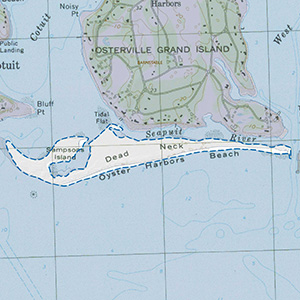Important Bird Area Sites in Massachusetts
Important Bird Area: Dead Neck and Sampsons Island
Site Summary
Nominated By
Matt Bailey, Scott Hecker
Size
15 acres
Towns and Counties
Cotuit, Osterville; Barnstable
Ownership
Mass Audubon, private
Major Habitats
pitch pine/scrub oak forest, maritime heathland/sandplain grassland, salt marsh, coastal beach, marine/tidal
Land Use
nature & wildlife, conservation/ land trust, recreation, undeveloped
Serious Threats
non-native invasive plants, succession, water/air pollution, disturbance to birds or habitat
Minor Threats
cowbird parasitism, predators, excessive soil erosion, degradation, recreational development/overuse
IBA Criteria
- Category 1: Sites important for long-term research and/or monitoring projects that contribute substantially to ornithology, bird conservation, and/or education.
- Category 4: Sites containing assemblages of species characteristic of a representative, rare, threatened, or unique habitat within the state or region.
- Category 5: Shorebirds: The site regularly supports 1,000 or more shorebirds at one time at a coastal site, during some part of the year, or a significant concentration of shorebirds at one time at a nontidal site. The designation "shorebirds" includes birds such as plovers, sandpipers, snipe, woodcocks, and phalaropes.
Site Description
The site is a Mass Audubon wildlife sanctuary. Sampsons Island is a barrier beach island 1.7 miles long by 0.125 to 0.25 miles wide, running east-west on the southern, Nantucket Sound side of Cape Cod. It is composed of a patchwork of dune and beach habitats. At the western end, the island begins with a spit of bare sand that grades abruptly to a beach grass field after only 65 to 100 feet. This beach grass encloses a 1-acre tidal cove before transitioning to a Pitch Pine-dominated late and then early successional heathland. The easternmost quarter-mile of the island is composed of a sandy plateau and beach maintained through placement of dredge spoil. This spoil is crucial in maintaining Sampsons Island's nesting colonies of rare and endangered waterbirds: Piping Plover, Least Tern, and Common Tern. The length of the southern side of the island is open beach while the northern side is a mix of beach and vegetation.
Current Conservation Status
Sampsons Island has a 20-year history of providing space for both recreational beach users and wildlife. It is an excellent example of how shared beach use can be accomplished while considering the interests of both groups.
Ornithological Significance
The island is home to 11 nesting pairs of Piping Plovers, 250 nestling pairs of Least Terns, 150 pairs of Common Terns, and a small gull colony. The island also provides a feeding and stopover site for foraging birds including Roseate Terns and a small number of herons and egrets. The island is a shorebird migration stopover and/or breeding location for at least four species of high regional conservation priority. This site is a location for long-term monitoring projects.
Other Flora or Fauna of Significance
The heathland of the island is a globally endangered habitat. Flora of special importance includes Broom Crowberry, Pink Lady's Slipper, and Butterfly Weed.
Data Sources
Flora of Sampsons Island, revised 7/10/89 by P. Dunwiddie, J. Anderson, & C. Leahy




